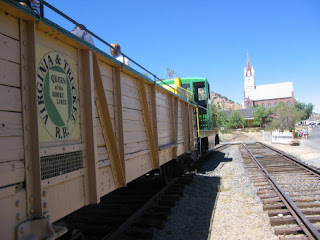
With a classy name like Vanderbilt, you’d expect that this 19th century mining camp would have had streets lined with gold or at least silver—but they were dirt and mud.
In fact, despite its promoters best efforts to develop a successful mining camp, Vanderbilt, which also went by the name, Vanderbilt City, never amounted to much more than unfulfilled promise.
The town was formed in 1870 after the discovery of promising silver-lead reserves in the surrounding area, which was called Secret Canyon. Within a short time, a small community cropped up near the Vanderbilt Mine (hence the name).
Within six months, Vanderbilt had about 150 residents, saloons, boarding houses and a couple of stores. Additionally, a ten-stamp mill was moved to the area from Hot Creek in Nye County and another facility, called the Sierra Mill, was constructed.
In August 1871, Vanderbilt seemed sufficiently substantial that a post office was opened. The optimism was to be short-lived.
Nearby Eureka was starting to boom and many of Vanderbilt’s residents decided to move on to the bigger camp. Soon, ore from Vanderbilt’s mines was also being shipped to Eureka, so the Sierra Mill was shut down. The mill was sold a few times, then destroyed in a fire in late 1872.
The fire signaled the end of Vanderbilt. The post office closed in summer 1873. Individual miners continued to work the local mines during the next few years and there was a small boom in 1880.
During this latter period, the town’s name was changed to Geddes, after Sam Geddes, owner of most of the local mines. The post office was reopened and Geddes and his partners built a massive 20-ton mill and furnace at a cost of $300,000, in anticipation of great profits.
While Geddes’ company was able to pull more than twice that in ore production, it took more than 20 years.
The camp muddled along through the 1880s, with the post office again closing in 1885, but the beginning of the end came in 1886, when the newer mill and furnace was destroyed in a fire.
Only small scale mining took place in the area after the late 1880s.
Today, Vanderbilt/Geddes is little more than a minor footnote in Eureka County’s rich mining history. The drive to the camp winds on a rough dirt road through a fairly steep canyon, located about five miles south of Eureka.
A few miles from Eureka, you can look up the side of a hill and spot a couple of wooden head-frames and the remains of a large ore bin. A bit further up the road, you come to a large tailing pile and the considerable ruins of the 1880 Geddes mill and furnace.
If you explore the site, you can find well-crafted stone walls, cement foundations and assorted rusted metal chutes, bolts and other mining paraphernalia.
Across the hill from the mill site, you can spot the remains of two stone buildings. The structures, built into the hillside, were made using local shale rock and wood. One still has a small window and frame.
Additionally, if you drive on the dirt road that travels above and behind the mill site, you can find the remains of two more intriguing structures. One appears to be the ruin of a fairly significant house with a brick chimney and interior walls covered with plaster.
The other is a more intact stone structure—although not enough is left to indicate if it was a house, store or storage building—built on the cliff overlooking the canyon. The view is spectacular but, strangely, its builders didn’t put in any windows to take advantage of the location.
To reach Vanderbilt, travel 1.5 miles east of Eureka on U.S. 50, then turn right onto an unmarked, winding dirt road (it’s called Secret Canyon Road). Continue for four miles to the former town site.
For more information on Vanderbilt pick up a copy of Shawn Hall’s excellent book, “Romancing Nevada’s Past, Ghost Towns and Historic Sites of Eureka, Lander, and White Pine Counties,” which available in local bookstores or from the Tonopah Historic Mining Park online gift shop, http://www.tonopahnevada.com/giftshop.htm.








